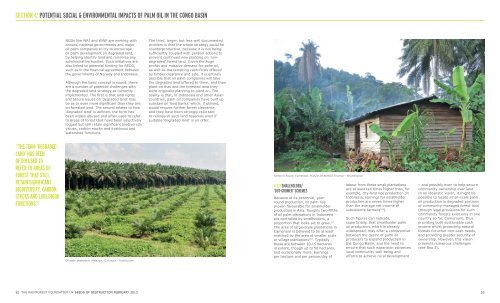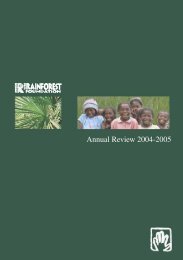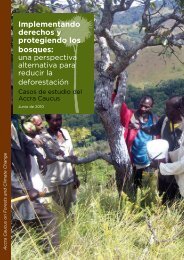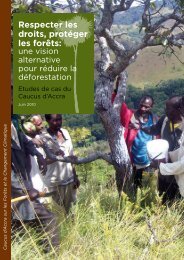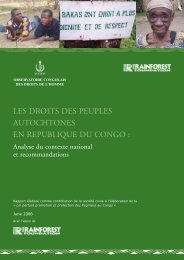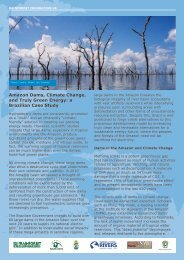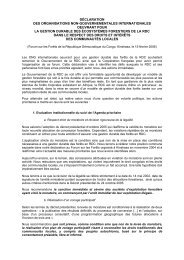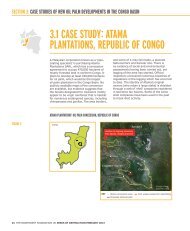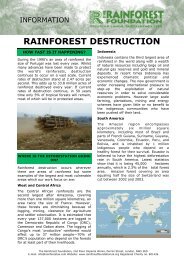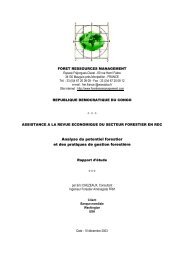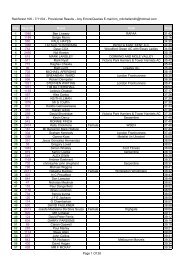Seeds of Destruction - Rainforest Foundation UK
Seeds of Destruction - Rainforest Foundation UK
Seeds of Destruction - Rainforest Foundation UK
Create successful ePaper yourself
Turn your PDF publications into a flip-book with our unique Google optimized e-Paper software.
SECTION 4: POTENTIAL SOCIAL & ENVIRONMENTAL IMPACTS OF PALM OIL IN THE CONGO BASIN<br />
NGOs like WRI and WWF are working with<br />
donors, national governments and major<br />
oil palm companies to try to encourage<br />
oil palm development on degraded land,<br />
by helping identify land and minimise any<br />
administrative hurdles. Such initiatives are<br />
also linked to potential funding for REDD,<br />
such as in the financial agreement between<br />
the governments <strong>of</strong> Norway and Indonesia.<br />
Although the basic concept is sound, there<br />
are a number <strong>of</strong> potential challenges with<br />
the degraded land strategy as currently<br />
implemented. The first is that land rights<br />
and tenure issues on ‘degraded land’ may<br />
be as or even more significant than they are<br />
on forested land. The second relates to how<br />
‘degraded land’ is defined; the term has<br />
been widely abused and <strong>of</strong>ten used to refer<br />
to areas <strong>of</strong> forest that have been selectively<br />
logged but still retain significant biodiversity<br />
values, carbon stocks and livelihood and<br />
watershed functions.<br />
The third, larger, but less well documented<br />
problem is that the whole strategy could be<br />
counterproductive, because it is not being<br />
sufficiently coupled with parallel actions to<br />
prevent continued new planting on ‘nondegraded’<br />
forest land. Given the huge<br />
pr<strong>of</strong>its and massive demand for palm oil,<br />
as well as the tempting cash-flows <strong>of</strong>fered<br />
by timber clearance and sale, it is entirely<br />
possible that oil palm companies will take<br />
the degraded land <strong>of</strong>fered to them, and then<br />
plant on that and the forested land they<br />
were originally planning to plant on. The<br />
reality is that, in Indonesia and other Asian<br />
countries, palm oil companies have built up<br />
substantial ‘land banks’ which, if utilised,<br />
would require further forest clearance,<br />
and they have been strongly reluctant<br />
to relinquish such land reserves even if<br />
suitable ‘degraded land’ is on <strong>of</strong>fer.<br />
“The term ‘degraded<br />
land’ has been<br />
<strong>of</strong>ten used to<br />
refer to areas <strong>of</strong><br />
forest that still<br />
retain significant<br />
biodiversity, carbon<br />
stocks and livelihood<br />
functions.”<br />
Oil palm plantation, Malaysia, © Kimpin - Fotolia.com<br />
Farmer’s house, Cameroon, POZZO DI BORGO Thomas - Shutterstock<br />
4.3.3 SMALLHOLDER/<br />
’OUT-GROWER’ SCHEMES<br />
Because <strong>of</strong> its perennial, yearround<br />
production, oil palm has<br />
proven favourable for smallholder<br />
production in Asia. Roughly two-fifths<br />
<strong>of</strong> oil palm plantations in Indonesia<br />
are controlled by smallholders, a<br />
proportion that looks set to grow. 217<br />
The area <strong>of</strong> large-scale plantations in<br />
Cameroon is believed to be at least<br />
matched by the area <strong>of</strong> smaller scale<br />
or village plantations 218 . Typically<br />
these are between 10-15 hectares<br />
in extent, though up to 50 hectares,<br />
and occasionally more. Earnings<br />
per hectare and per person/day <strong>of</strong><br />
labour from these small plantations<br />
are at least ten times higher than, for<br />
example, dry-land rice production (in<br />
Indonesia, earnings for smallholder<br />
production are seven times higher<br />
than the average net income <strong>of</strong><br />
subsistence farmers 219 ).<br />
Such figures can indicate,<br />
superficially, that smallholder palm<br />
oil production, which is already<br />
widespread, may <strong>of</strong>fer a compromise<br />
between the desire <strong>of</strong> palm oil<br />
producers to expand production in<br />
the Congo Basin, and the need to<br />
ensure that such expansion advances<br />
local community well-being and<br />
efforts to achieve rural development<br />
– and possibly even to help secure<br />
community ownership over land.<br />
In an idealistic vision, it might be<br />
possible to locate small-scale palm<br />
oil production in degraded portions<br />
<strong>of</strong> community-managed forest land<br />
(though legal provisions for such<br />
community forests exist only in one<br />
country so far, Cameroon), thus<br />
providing both sustainable cash<br />
income whilst protecting natural<br />
forests for other non-cash needs,<br />
and providing greater security <strong>of</strong><br />
ownership. However, this vision<br />
presents numerous challenges<br />
(see Box 3).<br />
52 THE RAINFOREST FOUNDATION <strong>UK</strong> SEEDS OF DESTRUCTION FEBRUARY 2013 53


